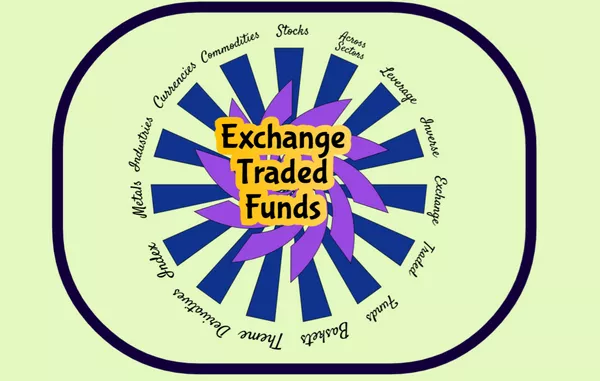Exchange-Traded Funds (ETFs) have gained immense popularity in recent years, offering investors an opportunity to diversify their portfolios with ease. With their flexibility, accessibility, and potential for solid returns, ETFs have emerged as a go-to investment vehicle for many. However, a pertinent question arises: Are ETFs truly backed by assets? In this article, we’ll delve into the mechanics of ETFs and explore the extent to which they are supported by tangible assets.
I. Understanding ETFs: A Brief Overview
ETFs are investment funds traded on stock exchanges, mirroring the performance of a specific index, commodity, or a basket of assets. They provide investors with a convenient way to gain exposure to a wide range of markets, sectors, and asset classes. ETFs offer the benefits of diversification, transparency, and liquidity, making them a popular choice among both individual and institutional investors.
II. The Creation and Redemption Process
ETFs operate under a unique mechanism known as the creation and redemption process. Authorized Participants (APs), typically large financial institutions, play a crucial role in this process. APs create new ETF shares by delivering a designated basket of securities, known as the creation basket, to the ETF issuer. In return, they receive newly created ETF shares, which can then be traded on the secondary market.
III. Index ETFs vs. Physical ETFs
ETFs can be broadly classified into two categories: index ETFs and physical ETFs. Index ETFs replicate the performance of a specific index by holding a representative sample of the underlying securities. These ETFs are not necessarily backed by physical assets but rather by a portfolio that aims to mirror the index’s composition and returns.
On the other hand, physical ETFs, also known as “fully backed” or “physically replicated” ETFs, strive to hold the actual assets they track. For example, physical gold ETFs hold physical gold bullions in secure vaults to back their shares. Similarly, physical commodity ETFs hold the respective physical commodities in storage facilities. These physical assets provide a level of tangible backing to the ETF shares.
IV. Synthetic ETFs: A Different Approach
In contrast to physical ETFs, synthetic ETFs employ derivative contracts, such as swaps, to replicate the performance of the underlying assets. These ETFs do not hold the physical assets directly but rely on financial agreements with counterparties. Synthetic ETFs are often used to gain exposure to hard-to-access markets or sectors that are not easily replicated physically. However, the reliance on derivatives introduces counterparty risk, as the ETF’s value is tied to the performance of the swap agreement.
V. ETFs and Underlying Asset Ownership
While physical ETFs hold assets that provide tangible backing, it is important to note that individual investors do not have direct ownership of the underlying assets. Instead, they own shares in the ETF, which represents a proportional interest in the fund’s assets. Investors benefit from the collective performance of the assets held by the ETF.
VI. Valuation and Transparency
ETFs offer investors transparency and real-time pricing, enabling them to monitor their investment’s value throughout the trading day. The net asset value (NAV) of an ETF is calculated by dividing the total value of the underlying assets by the number of outstanding shares. This NAV provides a fair approximation of the ETF’s intrinsic value.
VII. Investor Protections and Regulation
To safeguard investor interests, ETFs are subject to regulatory oversight. In the United States, the Securities and Exchange Commission (SEC) regulates ETFs, ensuring compliance with disclosure requirements, investor protection rules, and operational standards. Additionally, ETFs are typically structured as open-end funds, which allows for the creation and redemption process,
thereby ensuring that the supply of shares remains in line with investor demand and maintaining the ETF’s close tracking to its underlying assets.
VIII. Risk Factors to Consider
While ETFs offer numerous advantages, it’s important for investors to consider the potential risks involved. Some key risk factors include:
1.Market Risk: ETFs are subject to market fluctuations, and their value can rise or fall based on the performance of the underlying assets.
2.Liquidity Risk: Although ETFs are generally considered to be highly liquid, certain ETFs, especially those with lower trading volumes or exposure to illiquid assets, may face challenges in executing trades at desired prices.
3.Counterparty Risk (Synthetic ETFs): Synthetic ETFs rely on counterparty agreements, which expose investors to the risk of the counterparty’s default or inability to fulfill its obligations.
4.Tracking Error: ETFs aim to track the performance of their underlying assets, but there may be slight deviations due to factors such as expenses, transaction costs, and imperfect replication methods.
5.Regulatory Changes: Changes in regulations or tax laws could impact the structure, operation, or tax treatment of ETFs, potentially affecting their returns and benefits.
IX. Due Diligence for ETF Investors
To make informed investment decisions, investors should conduct thorough due diligence when considering ETFs. Some key steps include:
1.Research the ETF’s Objective: Understand the investment strategy, underlying assets, and index or benchmark that the ETF aims to track.
2.Evaluate the ETF’s Structure: Determine whether the ETF is physically backed or synthetic, and assess the associated risks and benefits.
3.Assess Costs and Fees: Consider the expense ratio, brokerage commissions, and any additional costs associated with holding the ETF.
4.Examine the ETF’s Tracking History: Review the historical performance and tracking error of the ETF to gauge its ability to closely replicate the underlying assets.
5.Consider Diversification and Portfolio Fit: Assess how the ETF aligns with your investment goals, risk tolerance, and overall portfolio diversification strategy.
Conclusion:
ETFs have become a popular investment choice due to their ease of use, diversification benefits, and liquidity. While the extent of asset backing varies depending on the type of ETF, physical ETFs provide a more tangible form of asset support compared to synthetic ETFs. Investors should carefully consider the structure, risks, and regulatory framework of ETFs before incorporating them into their portfolios. By conducting thorough due diligence and understanding the nuances of ETFs, investors can harness their potential benefits while managing the associated risks effectively.


